
PREFACE
Giorgetto Giugiaro
TEXT
Enzo Rizzo
PROJECT EDITOR
Valeria Manferto De Fabianis
EDITORIAL COORDINATION
Laura Accomazzo - Giorgia Raineri
GRAPHIC DESIGN
Maria Cucchi



PREFACE
Giorgetto Giugiaro
TEXT
Enzo Rizzo
PROJECT EDITOR
Valeria Manferto De Fabianis
EDITORIAL COORDINATION
Laura Accomazzo - Giorgia Raineri
GRAPHIC DESIGN
Maria Cucchi

Preface by Giorgetto Giugiaro page 8
Introduction page 10
Chapter 1 page 20
Italy starts up its engines: the first manufacturers, the early bodywork
Chapter 2 page 60
The 1920s, a unique decade
Chapter 3 page 88
From the crisis in 1929 to the war

Chapter 4 page 122
The post-war period: Italian style is born
Chapter 5 page 170
From the Dolce Vita of the 60s to the crisis in the 70s
The epic changes of the 80s and 90s Chapter 7
The Third Millennium
The automobile is one of the symbols of Made in Italy around the world. Its success is the result of the genius and creativity of a select group of Italians, and a culture and history that has allowed the country to set the standard for good taste through great intuition and revolutionary creations.
It is true that the automobile was born in Germany, but it was in Italy that the first internal combustion engine was invented, in 1853, thanks to Eugenio Bersanti and Felice Matteucci. The first mass-produced eight-cylinder engine was used for the Isotta Fraschini Tipo 8 in 1919, the 1922 Lancia Lambda was the first vehicle in the world with independent wheels and a bearing body and structure, and the 1947 Cisitalia 202
by Pinin Farina became the standard for sports cars, just as Castagna’s 1914 Alfa Romeo for Count Ricotti was the precursor to the modern minivan. And then you have the first Formula One World Championship, won by Alfa Romeo in 1950, and the world’s first expressway, the Milano-Laghi built in 1923.
There is an incredible group of Italian personalities whose names are identified automatically with cars, many of which are still in business today: Enzo Ferrari, Vincenzo Lancia, Nicola Romeo, Ferruccio Lamborghini, Alfieri Macerati and Ettore Bugatti, to name a few. And then there are the car designers. In addition to Giorgetto Giugiaro, there was Pinin Farina and Bertone, Scaglietti and Zagato, plus others who worked for car manufacturers, such as Marcello Gandini or Flavio Bertoni who was behind many Citroën masterpieces.

Italian design engineers include Vittorio Jano for Alfa Romeo, and Dante Giacosa for the Fiat that introduced an industrial aspect to Italian cars and became a pioneer for the modern city car.
Last, but certainly not least, is Italy and motor racing. Italians are spoiled for choice in terms of race car drivers and winning cars, and their feats have contributed to a rich international history in this field.
This book tells the story of the Italian automobile through men, vehicles and ever-changing conditions. The chapters follow a chronological format that reviews social, economic and political factors, both in Italy and internationally, as well as the various eras of the Italian car and its development based on design generations and mechanical innovation.
1 The Ferrari 308 Gts (Gran Turismo Spider) made its debut in 1977 with a rigid removable top that made it a coupe.
2-3 The 1995 Ferrari F50 celebrated the trademark’s 50th anniversary. It boasted the best Formula One technology applied to a road-legal model.
4-5 The Maserati A6 GCS was presented in 1954 and immediately dominated races due to its speed and handling.
6-7 Elegant shapes for a sports car that undisputedly dominated races in the 1930s: The 6C 1750 Gran Sport, Alfa Romeo’s signature model.
10-11 The 1962 250 Gto (Gran Turismo Omologato) is one of Ferrari’s masterpieces. Sergio Scaglietti can be credited with its sensual and still modern shape.
12-13 This yellow Lancia Astura is from 1935. Its convertible version was often used as a presidential automobile.
14-15 The Isotta Fraschini Tipo 8 was manufactured from 1919 and was considered to be the most elegant, exclusive and sophisticated car in the world at the time. It was equipped with the first mass-produced eight-cylinder engine.

16-17 3600 units of the Ferrari 550 Maranello were manufactured between 1996 and 2002. It was equipped with a V12 5.5L (5474 cc), 485 hp engine that had a maximum speed of 199 mph (320 km/h).
18-19 This 2006 Ferrari P4/5 was the only one made and was produced for American James Glickenhaus by Carrozzeria Pininfarina based on an Enzo. Glickenhaus was also able to get his hands on the first Alfa Romeo 8C Competizione ever exported to the United States.
talians, a people of poets, saints and seafarers.” And motorists. Right from the beginning of the car’s history, Italians have writ-
ten many of the most important pages. The first automobile driven by a spark-ignition engine was created in Germany in 1886, by technicians Karl Benz and Gottlieb Daimler, and the time was
ripe for its fast distribution. So much so, in fact, that the birth of the automobile occurred only a short time thereafter, in France, England and Italy. Benz and Daimler respectively put three- and four-wheel vehicles, respectively, on the road at the same time but unbeknownst to each other. In 1924 they joined forces and two years later created Daimler-Benz, which we know today as Mercedes-Benz. These two men marked the start-
Previous pages Fiat founder, Senator Giovanni Agnelli with Luigi Storero, the owner of a factory that made bicycles, tricycles and quadricycles (such as the Phoenix on which they are photographed), after winning the race in Verona in 1899.
Left The drawings are of engines invented by Eugenio Barsanti and Felice Matteucci (from Lucca). The two Italians are considered the fathers of the spark-ignition engine, which was patented in England in 1854.
Right The 1854 Bordino steam-operated carriage is actually on display in the Carlo Biscaretti Ruffia Auto Museum in Turin. It is basically a Landau, a type of carriage for several people that is not drawn by horses but is equipped with a rear water tank and an engine under the cabin.

ing point of the car after a period of experimental models that moved on their own through the use of steam or electric traction, and the concept of the true automobile with an internal combustion engine came closer to reality.
In France, similar endeavors included Cugnot’s three-wheel military vehicle, created in 1769 to transport artillery, and the steam versions that increasingly resembling automobiles from the sec-


ond half of the 19th century, created by Amédée Bollée, Léon Serpollet and Georges Bouton. These gentlemen founded a company in 1881 with the eclectic Jules-Albert de Dion, the founder of the Automobile Club of France, the world’s first automobile association and a depositary of well-known mechanical patents that are still in use, such as the De Dion wheel axle bridge. Britain’s precocious industrialization sustained a certain confidence and steam traction was used to drive public carriages. Several manufacturers even drove around in single models they had invented, like Walter Hancock in his 1838 phaeton four-seater. However, electric traction was preferred in the United States. The first electric taxis circulated in New York in 1894, and there was also the torpedo-shaped La Jamais Contente (Never Satisfied) driven by Camille Jenatzy, which reached speeds in excess of 62 miles per hour (100 kilometers per hour) in 1899. Preference was purely a matter of practicality; with steam, it took one hour to heat up approximately 26 gallons (100 liters) in the tank and create pressure in the engine, not to mention frequent stops at a friend’s place or a public fountain to fill up with water.
In Italy, steam provided the drive to a two-cylinder engine mounted on the Bordino Carriage, a Landau carriage created in 1854 at a military base in Turin, which is now actually on display in Turin’s Biscaretti Museum. The vehicle was named after Virginio Bordino, an officer in the Sardinian army. Bordino made use of the experience he gained in London, where he was sent to study methods of transportation that could be of service to the army. Despite an initial preference for electric or steam engines, however, the spark ignition engine was chosen for the automobile because it was not difficult to use nor did it require a lot of strength to start up with a crank (especially for women). It was also quiet, didn’t vibrate and didn’t require gears. However, continuous experimentation and never-ending improvements in efficiency, functionality and ease of use ultimately led to the distribution of units equipped with internal combustion engines. The fathers of the spark-ignition engine are consid-
ered to be Italians Eugenio Bersanti and Felice Matteucci. These two gentlemen registered a paper at the Georgofili Academy in Florence in 1853 related to the construction of their spark-ignition engine, which was patented the following year in England. In 1882 a Veronese professor of mechanical construction at the University of Padua named Enrico Zeno Bernardi patented a gas-operated spark-ignition engine. It was a single-cylinder 0.1 liter (130 cubic centimeters) engine with less than one horsepower, used initially to operate small machine tools. In 1884 he assembled it on a wooden tricycle for his son Lauro and, 10 years later, he assembled it on a three-wheel vehicle, the Triciclo. In the meantime, he obtained 0.6L (600 cc) with 1.5-2.5 hp. It required two pounds (800 grams) of gas per hour and could reach between 17 and 22 mph (28 and 35 km/h), depending on the horsepower.
Another year would pass, however, before the birth of the first Italian automobile. It was 1895, in Roncade in the Italian province of Treviso, that craftsman Carlo Menon built a small, four-wheel vehicle with a single-cylinder, air-cooled, 0.5L (490 cc), 3.5 hp De Dion-Bouton engine. It was named the Rebus and was the first Italian automobile to be mass produced. Menon subsequently fine tuned and built the engine on his own, obtaining good results in terms of reliability and solidity. He was able to produce 20 or so automobiles (one still “operated” by his heirs) until 1902, when the production of this small vehicle become secondary to producing velocipedes, weapons and ammunition.
In 1912 came the Zero, a cornerstone in technological evolution not only for Fiat, but for the entire Italian automotive industry. In fact, 2000 units of this car were manufactured by 1915, but more importantly, it was mass produced on assembly lines, from the chassis to the bodywork and mechanics. This was thanks to the exchange of technology with Ford in the United States. On one of his overseas trips to the American company’s workshops, Agnelli saw for himself what was meant by so-called ‘Fordism,’ the industrial production system created by Henry Ford and realized in an assembly line, an automated handling system connecting all processing operations of an automobile’s individual components in sequence with the assembly procedures. The effect that this method had in reducing the final price of the product was decisive. The reductions
in costs and time were just as impressive as the increase in production. Imagine, Ford went from manufacturing 34,550 Model T vehicles in 1911 to 248,307 in 1913, while the time required to make a car decreased from 750 minutes to only 93.
Fiat drew on this revolutionary production system completely and, after combining it with
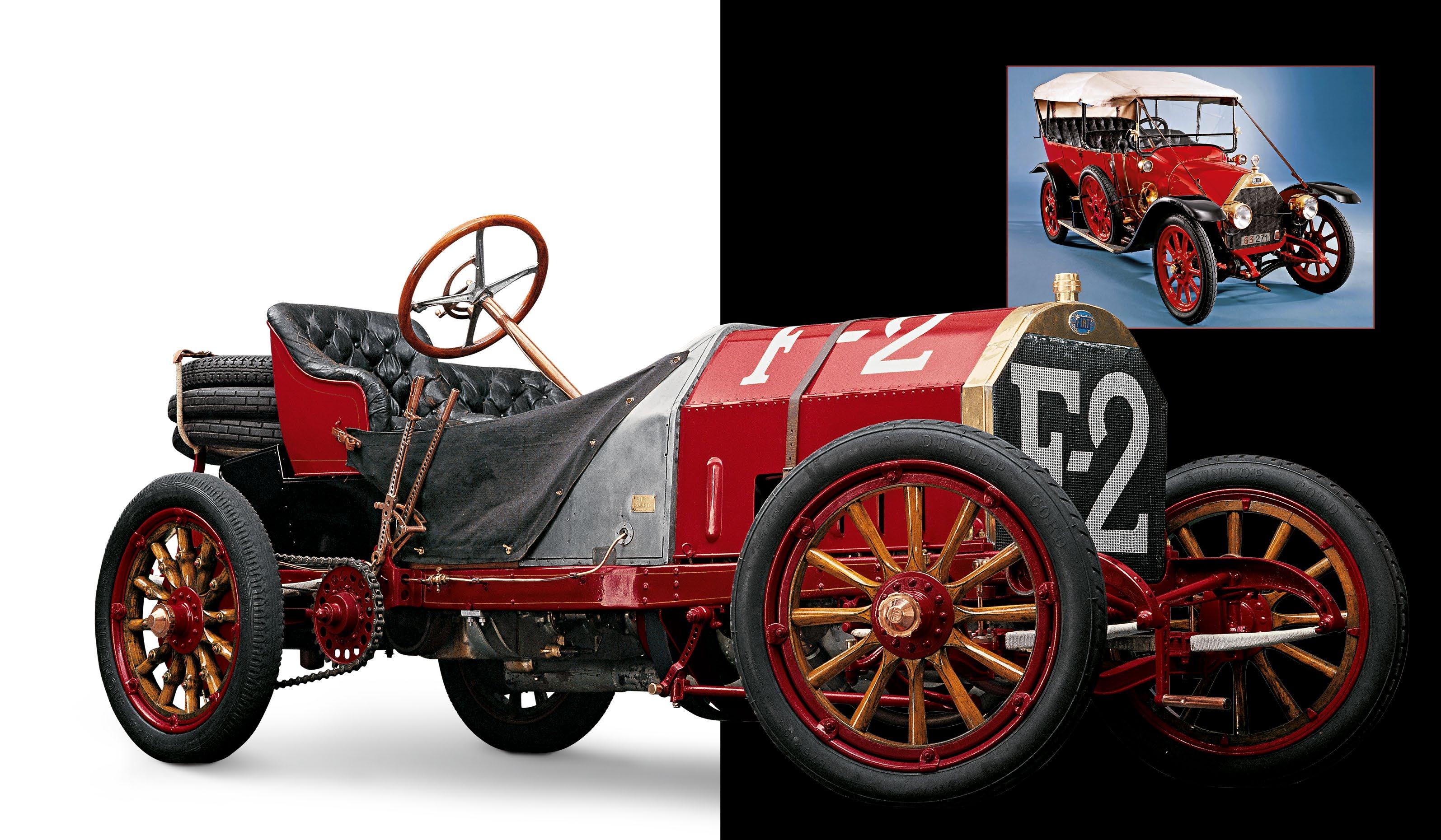
several Taylorist methods, applied it to the Zero, with thrilling results. The car’s original selling price decreased from 8000 Lira to 6900 Lira in 1913 because production costs had benefitted from initial amortization. Initially, the Zero came in a single version, equipped with a 1.8L (1847 cc) engine and a single, torpedo-shaped body that seated four.
This marvelous 1907 red Fiat 130 HP was equipped with a 16.3L (16.286 cc), 130 hp engine and reached a maximum speed of 99 mph (160 km/h). Three cars were lined up at the 1907 French Grand Prix driven

A 1912 red Fiat Zero. This was an important model for Fiat and the Italian automobile industry. It was the first car built entirely - from the chassis to the bodywork – on an assembly chain and therefore intended for mass production.
Those automakers that made it to World War I but failed to expand their plants or standardize production as the automobile’s industrial system demanded, were lifeless after the conflict and lacked the capital and ideas they needed to avoid being crushed by the competition. The Great War, just like World War II, led to natural selection. Only the strongest and most organized survived and were able to continue their journey and create a page in history. Another
uncertainty was production and machinery reconversion. Italian manufacturers, like those around the world, were further screened by the return to normality and changes in demand from bullets and heavy vehicles to cars used for civil purposes. Yet another painstaking reason was the Italian government’s full or partial failure to make payments for the war job orders, which had been the only client during the war. Just when the economy was showing signs of recovery and the period of interrupted production and consumption due to high unemployment seemed over, the Wall Street crash of
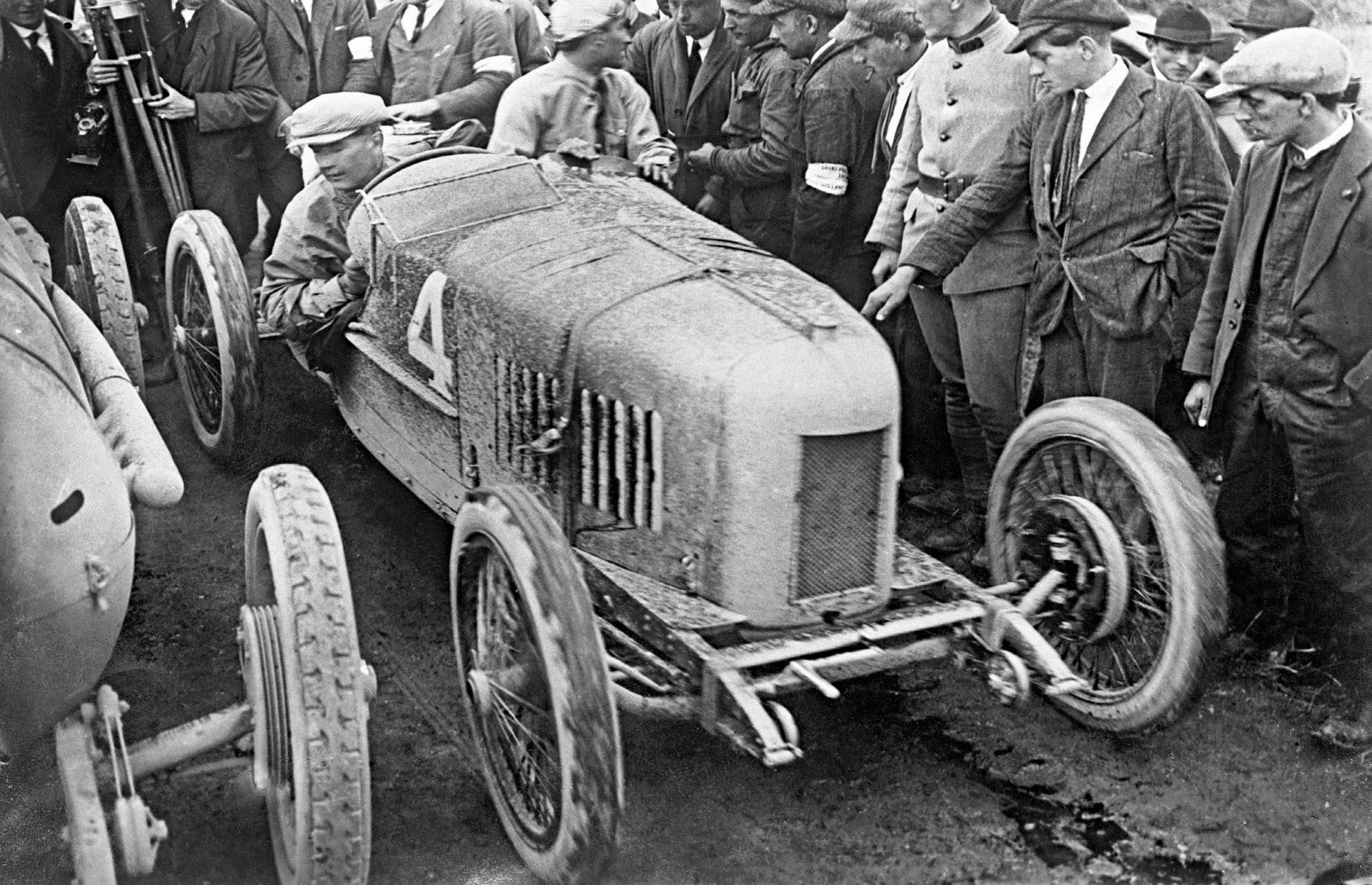
1929 came along, leading to a deep economic depression. Despite this disconcerting picture, which was tied both to a political crisis and deep-rooted nationalism that led to Fascism, Italy’s automobile sector experienced a time of great prosperity. It offered great technological innovations on one hand and style and elegance on the other that was highly regarded and sought after around the world. The number of Italians behind the wheel multiplied along with the number of vehicles on the road, which increased from 24,000 vehicles in 1919 to in excess of 186,000 at the start of the

1930s. The first highway in the world, the Milano-Laghi, was inaugurated in 1923. The number of manufacturers slowly decreased, however. Those that continued included an evolving Fiat, which motorized Italy, Lancia, with its characteristically elegant, comfortable and innovative models, and Alfa Romeo, which stood out for its sportiness, allowing it to reap success in races and boast international admirers – including Henry Ford, who famously said, “When I see an Alfa Romeo go by, I tip my hat.”
Companies like Ansaldo, Chiribiri, Diatto, and SCAT closed down while Bianchi, Isotta Fraschini and Itala experienced a period of crisis. A few new manufacturers were merely flashes in the pan, such as Ansaldo, an engineering complex and one of the most important corporate structures in Italy, which produced everything from manufacturing airplanes and ships to railway material. In 1919, it began manufacturing automobiles with the necessary quantity and quality to ensure longevity, but it experienced economic misfortunes and a financial crisis, and the final blow arrived with the great depression. Another example was Nazzaro. In 1919, racing driver Felice Nazzaro again attempted to transfer the experience and notoriety he had gained from racing into success as an automaker, but just as had happened the first time (from 1912 to 1916), he closed down after four years and returned to Fiat as a test and racing driver. One company that had a slightly longer history was Temperino, named after two brothers. In 1919 the brothers, who were first bicycle and later motorcycle manufacturers, began producing a small vehicle based on a project developed before the war. It was the 8-10 HP with various bodies, from an open sports car to a two-seater and van with a moderate-sized engine. It was successful, thanks to race victories and, as a result, the Temperino brothers negotiated production agreements with Opessi (a Turinese weights and measures factory) and with Farina, who produced the bodies Opessi
had already been called to participate in the birth of Fiat). Temperino also succeeded in its export endeavors and opened an English branch, but it was not able to survive the economic crisis and closed down in 1925. Saba, a small Milanese company, operated from 1923 to 1928 and stood out for the production of its Stelvio model, which was the first Italian 4x4 and was also equipped with four-wheel steering. Economic problems prevented it from being marketed.
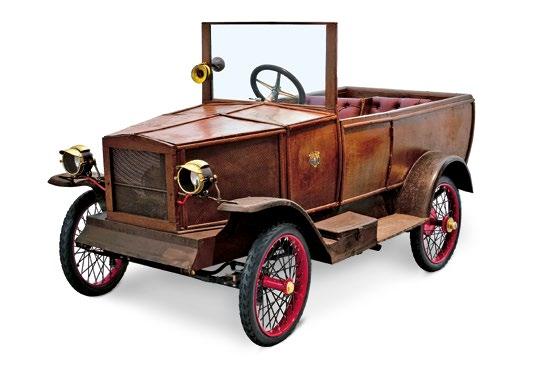

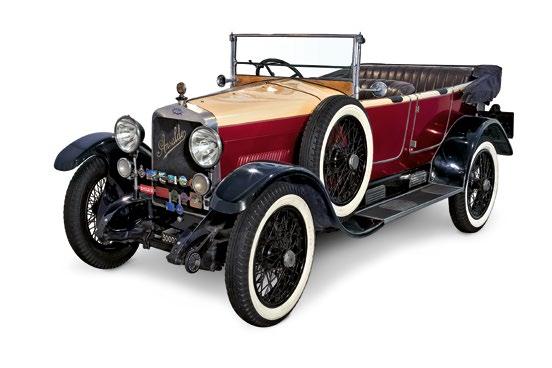


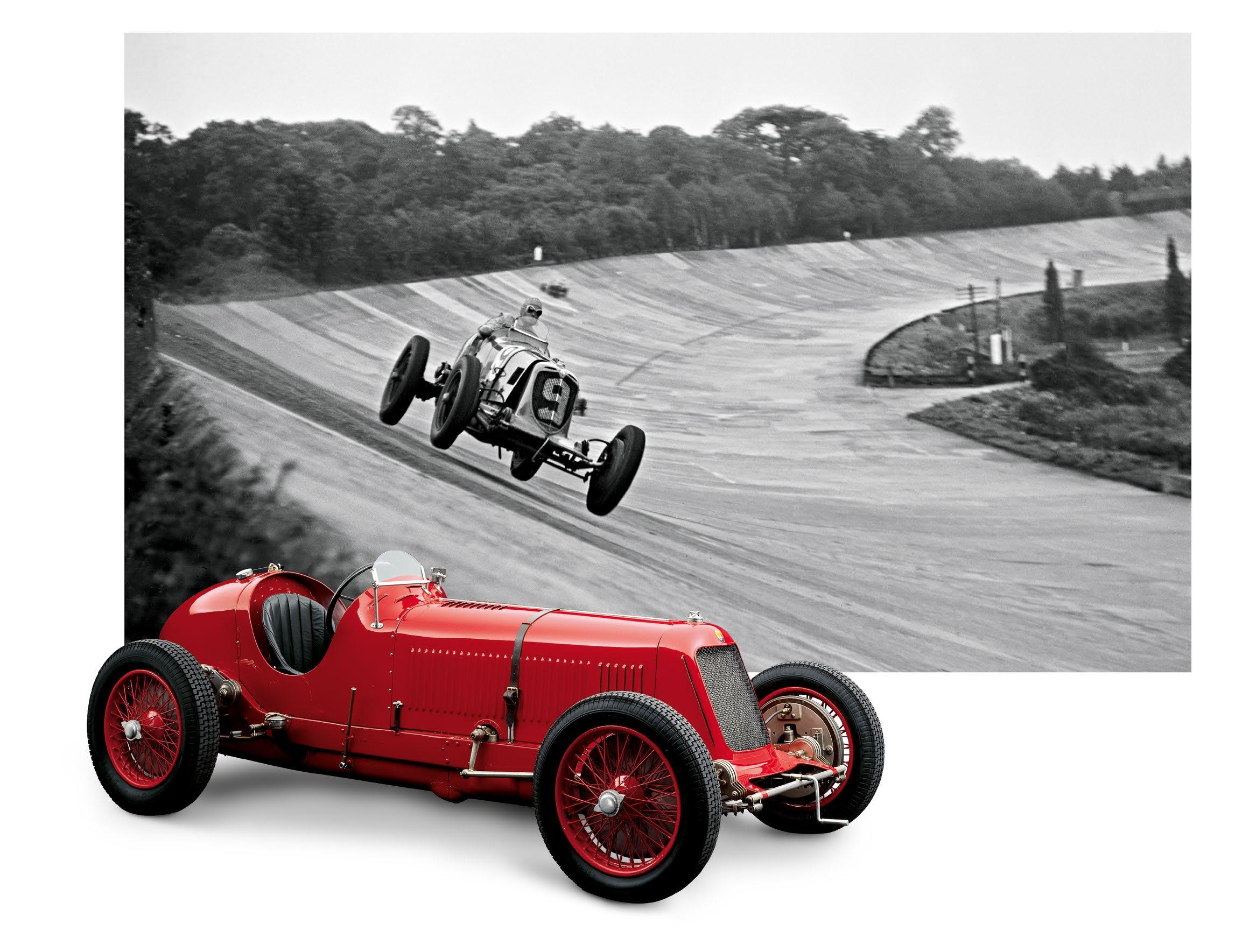
Previous pages Alfa Romeo participated in the 1936 Mille Miglia with its new 8C 2900 B and took first, second, and third places.
Top left Prince Bira of Siam on a curve on the Brooklands Campbell Circuit in his 3.0 L (3000 cc), eight-cylinder Maserati during the Junior Car Club 200 Mile Race held on April 27, 1938.

Bottom left Tazio Nuvolari also helped develop the 1933 Maserati 8CM. It won the Belgian, Montenero and Nice Grands Prix with Mantovano behind the wheel and was a match for Mercedes and Auto Union.
Right A mechanic services and fine-tunes a 1938 Maserati 6CM.
During the period between the Wall Street crash of 1929 and World War II, Italian automobile shapes took a new course. Developments in aerodynamics gave life to tapered and tear-shaped models with tilted windshields and radiators and lights increasingly integrated in the front end, while fenders were moved in closer to the body of the vehicle and running boards disappeared for good. Automobile production quantities seesawed and, consequently, so did sales.
make a tangible mark in history. Races were a formidable resounding vehicle for the four-wheelers – particularly the Mille Miglia.
Alfa Romeo’s successes with models bearing the Milanese trademark were even able to seduce Mussolini (a great automobile enthusiast) and to persuade the average Italian, who loved and cars and invested them with values far beyond that of a simple means of transport. Individuals also had to consider the purchasing power of their wages, however, which generally did not allow them to buy the vehicles they wanted.
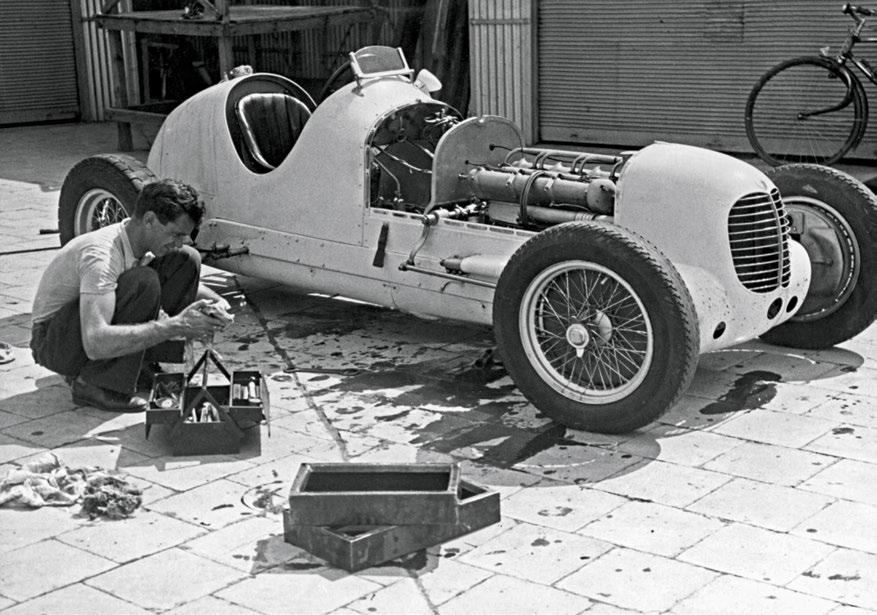
This did not prevent the spread of motorization, although it still was not something for the masses. Fascism contributed, through the construction of highways, to an increase in the number of vehicles in circulation.
In truth, the regime’s intent was more than just making cars an item for the masses. Rather, it intended to demonstrate its ability to innovate and follow technological progress, allowing it to
For example, a worker in their mid 30s earned approximately 350 Lira per month, a blue-collar worker 250 Lira and a farmer less than 100 Lira. If a Fiat Topolino cost 8900 Lira, a Lancia Ardea 29,000 Lira and an Alfa Romeo 8C as much as 91,000 Lira, it is understandable that the car remained a dream for many and the bicycle continued to do the job (considering that one could be purchased for under 600 Lira).
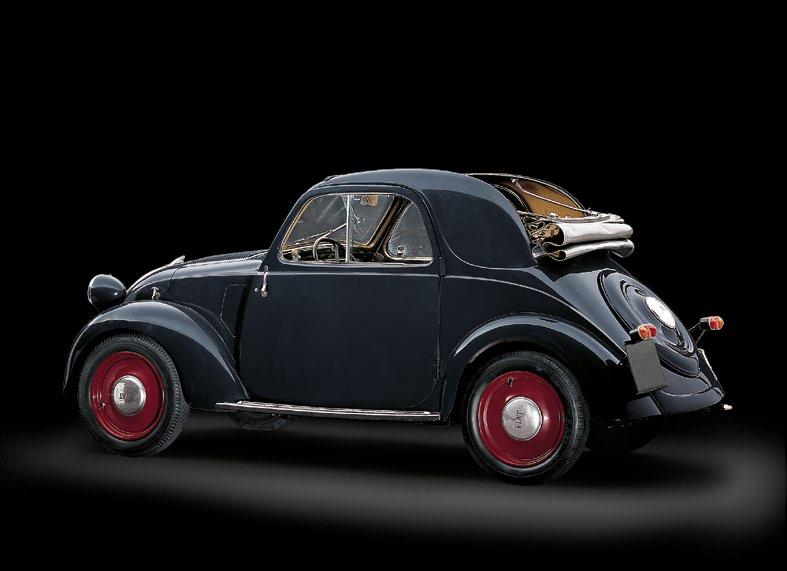


The Fiat 500 A Topolino was truly a likeable vehicle –- even the soft top version that almost made it a convertible. When it made its debut, it was the smallest four-seater in the world (fitting two adults and two children or baggage). It achieved this goal thanks to the position of the engine’s center of mass outside the wheelbase and to the suspension front leaf springs, which were replaced by a single and less cumbersome, semi-elliptical transversal leaf spring.
Italy didn’t exactly start over from scratch after World War II, but it wasn’t far off. The country was disfigured by bombings and automakers’ factories were one of the sensitive targets because they had produced war material, from trucks to airplane engines and ammunition. As in other countries, ideas and projects were set in motion during the recovery, starting with pre-war models that were duly updated. Car designers proposed new models with more streamlined and reactive structures, perhaps by exploiting a chassis that was buried in the back of the warehouse somewhere. However, the trend was marked and continued in the wake of the
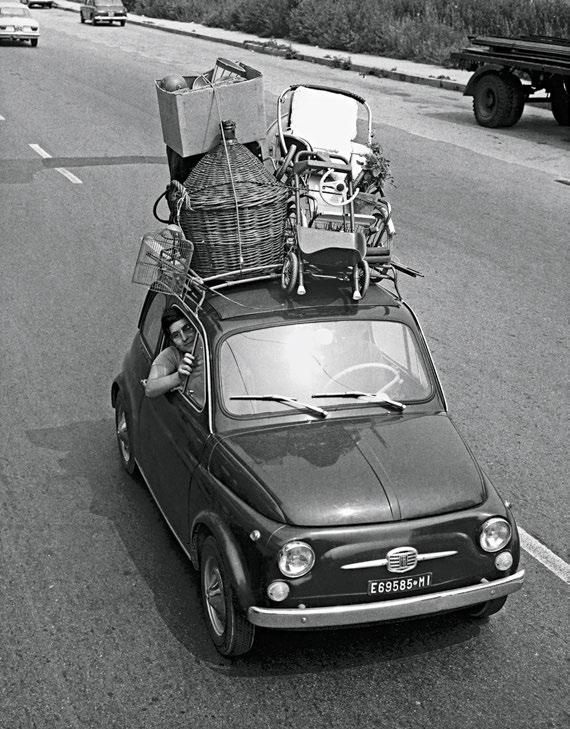
transformations that had been underway during the 1930s. Automobiles took the shapes we are used to seeing today, with bodies integrating all those elements that were originally separate from the vehicle’s bodywork, such as the radiator, lights and fenders, giving life in the fifties to what designers refer to as the fourth phase, that is, the modern car.
Italy was among the leaders despite starting with a handicap; in fact, it was precisely this disadvantage that spurred on the automobile industry. Its car designers and stylists created vehicles that symbolized the history of the car and led the country through the 1950s, the first decade in which more than 100,000 vehicles were sold in Italy (112,110 in 1953), which towards the end of the decade, led to mass motorization and the economic boom that continued through 1964. In 1958 the Italian market delivered 830,175 vehicles and over a million in 1966. Up to that point, Italy – which had a developed system of automobile distribution – was still behind other European countries in terms of motorization. Despite this, increased motorization not only meant organizing a suitable roadway network that was able to move traffic, but also meeting the need to travel quickly in a car, thanks to the performance of the models of the time.
The endeavors of Italian vehicles and racing drivers in international races spurred motorists further. The Autostrada del Sole highway was built, the result of an impressive policy to build highways, unrivalled in Europe and later known as the Fanfani Plan . The first stone was laid on May 19, 1956 and started a plan that provided for roadways in excess of 3311 miles (5329 km). The development of Italy on four wheels had begun, never to be stopped. Until the 1970s, with its oil shocks and Sundays on foot, no war or crisis for 30 years could stop this development, which allowed Italy to express itself in terms of the automobile.
However, this period is also remembered for all the deaths that the Italian world of engines brought with it. When Giovanni Agnelli died in 1945, his dear, faithful friend Vittorio Valletta was named president of Fiat in his place. Valletta had started
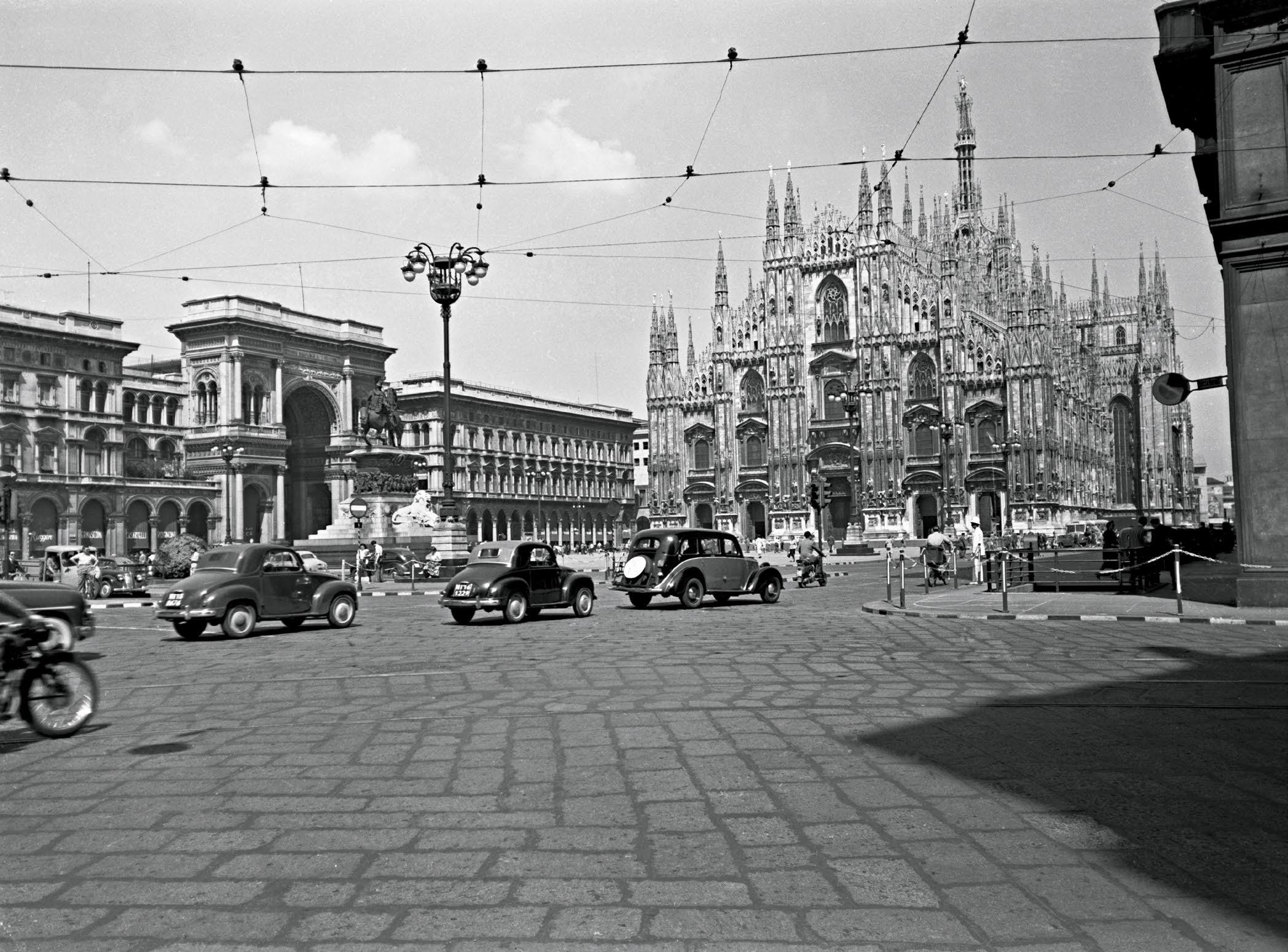
with the company in 1921 as an administrative manager and was able to carry Fiat through years of crisis, providing it with the growth it needed to survive, indulge mass motorization and make a permanent mark on the international automobile scene.
In 1947, it was the turn of Ettore Bugatti. The death of this genius and his farewell to his

beloved birthplace of Milan (although he was buried in the family tomb in Dorlisheim, close to Molsheim) led to the permanent decline of his car manufacturing company. It had already sustained a serious blow with the death of his son Jean in 1937 while test driving the Tipo 57 close to the factory in Molsheim. Many racing drivers lost their lives, while racing or just taking a test
drive. Racing without limits and without the safety and protection we take for granted today, was very risky. Often it took the death of these drivers to establish a vehicle’s maximum speed.
In a way, perhaps it was better like this. The ego and passion reached a climax when they left the scene, like heroes on the field of battle, rather than like common mortals in a bed.
Previous pages The 1958 Ferrari 250 GT Coupe Tour de France race version. Unlike road-legal versions, this one was equipped with a small wheelbase for increased agility.
Left A Fiat 500 with a full load on the roof. This small Fiat started its brilliant career in
1957; it had room for four, but finding room for luggage was certainly a challenge.
is today.
The Shah of Persia ordered one of the most prestigious Maserati models at the time. The very elegant and fast 1959 5000 GT sports car (clients could personalize it by directly dealing with the coachbuilder) was equipped with an eight-cylinder engine taken from the race versions and its bodywork was first created by Touring and later by Pinin Farina, Ghia, Frua, Monterosa and Allemano. Of the total 34 units produced, one came off the production lines with no words or Tridente logos; this one was for Fiat deputy chairman Gianni Agnelli. Postwar, Maserati was managed by the Orsi family after it had taken the company over from the Maserati brothers in 1937, although the brothers continued collaborating until 1947 as managers of the engineering department. That was also the year that the A6 1500 made its debut, giving the sporty 6CM a commercial outlet. This was another shining example of a streamlined sporty vehicle with a long front end and recessed lights, which gave way to a series of elegant GT models allowing the automaker to carve out a niche for itself in this market segment. After the 1951 A6G 2000 and 1954 54, the 3500 GT made its debut in 1957 and encountered significant success (1972 units were manufactured), pulling the company out of the economic crisis in which it had found itself. This vehicle confirmed that Maserati was synonymous with elegant, streamlined, comfortable and fast vehicles that were easy to drive.
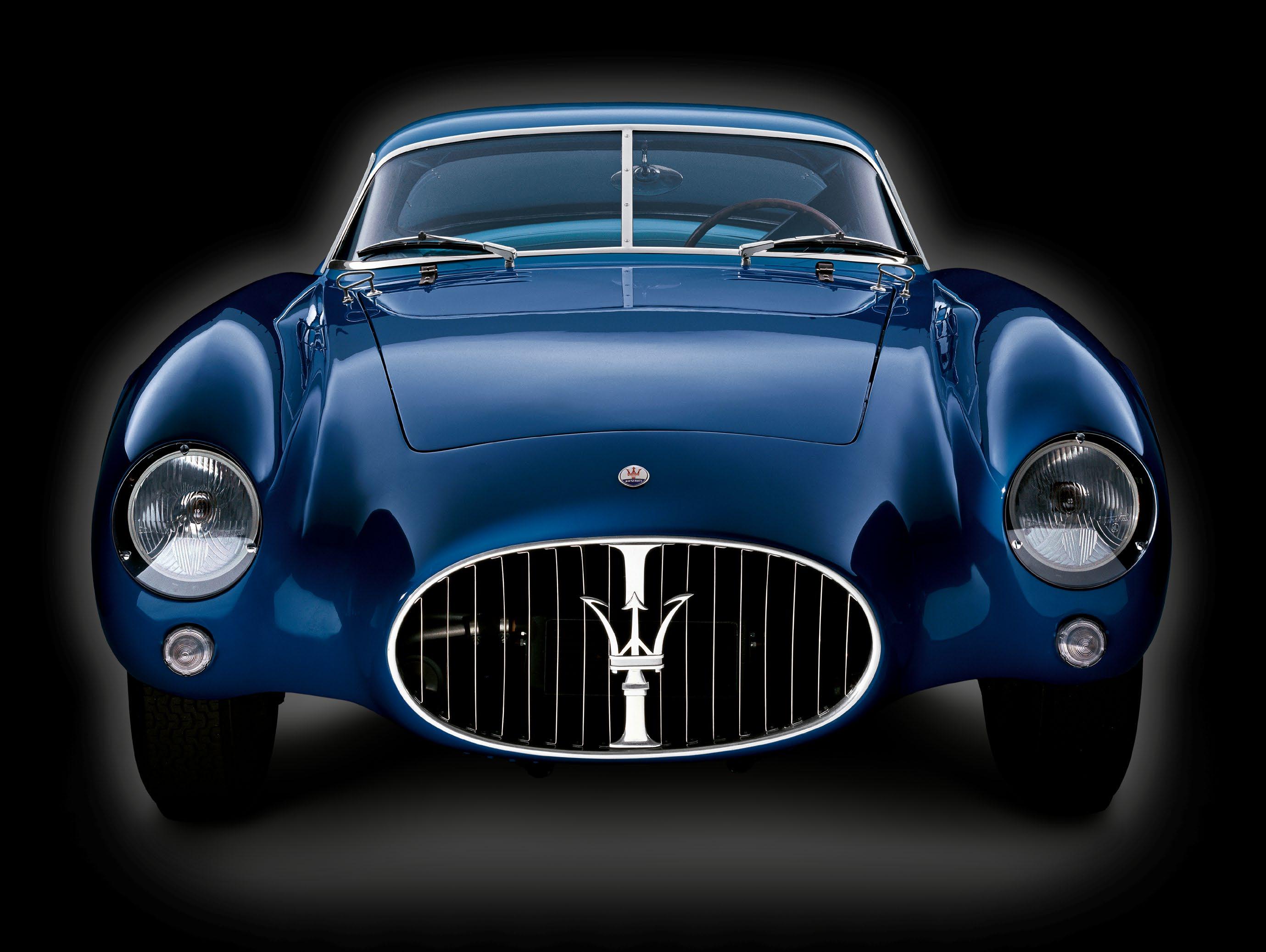

The bodywork of this 1954 Maserati A6 GCS is by Pinin Farina. The car made its debut together with the A6 1500 and immediately won the Modena Circuit (with Ascari behind the wheel). It was equipped with a six-cylinder cast-iron engine (cast iron in Italian is ghisa, hence the G in the name).

The Fiat 500 was an icon and a pioneer of the modern city car. Likeable, revolutionary and original, it made its debut in 1957, remained in production until 1975 and made a comeback in 2007 in an entirely new version inspired by the shapes of the original model.